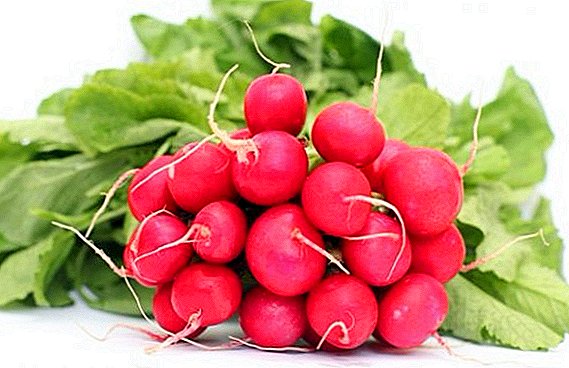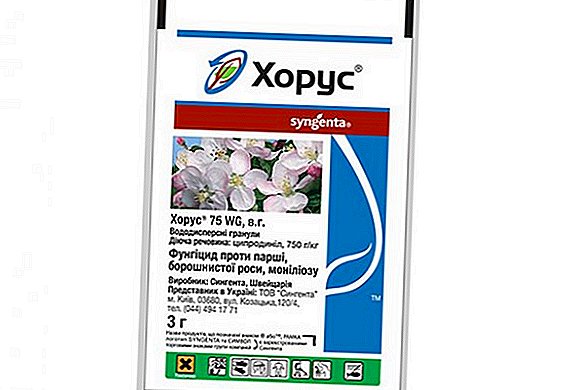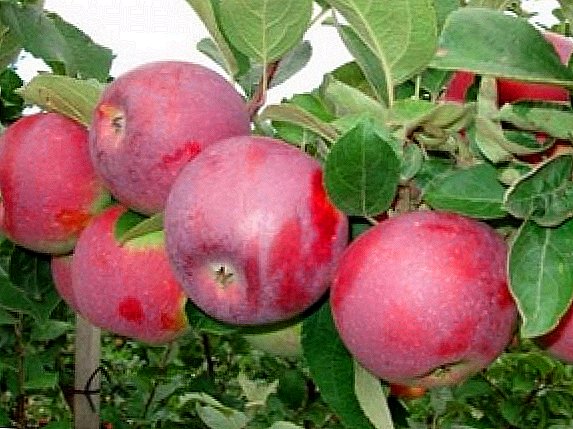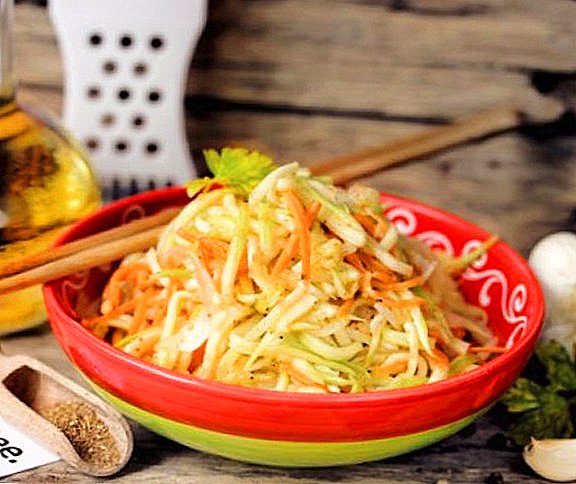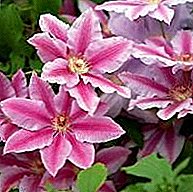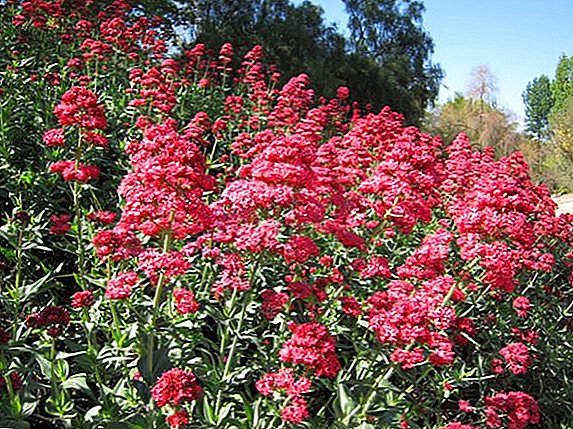 Kentrantus "Raspberry Jingle" was derived relatively recently, but has already become popular among gardeners because of its bright unusual colors and unpretentious care. In our article we will give a description of the plant, as well as talk about all the intricacies of growing it on your garden plot.
Kentrantus "Raspberry Jingle" was derived relatively recently, but has already become popular among gardeners because of its bright unusual colors and unpretentious care. In our article we will give a description of the plant, as well as talk about all the intricacies of growing it on your garden plot.
Botanical description
Kentrantus "Crimson Jingle" - perennial with abundant and long flowering. Shrub branching, it reaches a height of 60 centimeters, and grows to a width of 50-60 centimeters.
Stems loosely arranged and covered with green leaves with an unusual bluish tinge. The lower leaflets have small scapes, the upper ones sit tightly on the stem.
Flowers abundant, bright crimson color, not exceeding a diameter of 1 centimeter. They are collected in large branched dome-shaped inflorescences.
Flowering occurs twice a season - the first one comes in June-July, the second - in August-September. Seeds ripen in a box, easily spilling out of it and carrying out a constant self-seeding. During the season, full ripening of seeds occurs twice. 
Spread
The homeland of Kentrantus is considered the Mediterranean and Portugal, where it is distributed in the wild. Bushes grow on warm stony sites, walls and rocks. The plant can be found in Southern and Central Europe, in the territory of Russia Kentrantus is distributed mainly in the southern regions.
Application in the garden and landscape design
Kentrantus is widely used in landscape design due to its beautiful colors and compatibility with other plants. It acts as a background plant for flower beds and borders.
This bush will be able to fit well into the gardens of various styles, it will look great on the sunny side of the cottage garden and in the gardens of the Mediterranean type.  In microborders, adonis, oak sage and other perennials will perfectly combine with this bush. Most often, Kentrantus is used in group plantings, creating original flowering zones in gardens. Also, the plant is well suited for decorating the area around the paths and arbors, it is planted on the slopes, retaining walls, in rocky rock gardens and rockeries.
In microborders, adonis, oak sage and other perennials will perfectly combine with this bush. Most often, Kentrantus is used in group plantings, creating original flowering zones in gardens. Also, the plant is well suited for decorating the area around the paths and arbors, it is planted on the slopes, retaining walls, in rocky rock gardens and rockeries.
To decorate a garden plot, we advise you to read about how to make rock arias, a dry stream, a fountain, a waterfall, a mixborder, a rose garden, paths from spil of wood and concrete, an alpine slide, and a flower garden made of wheel tires and stones.
Growing at home
To grow the "Raspberry Jingle" Kentrantus at home, you need to follow simple instructions.
Choosing a landing site
This plant is sun-loving and reacts poorly to cold, draft and strong shade. Therefore, the site for planting is necessary to choose a light, open and without signs of moisture.  Preparing for the winter for kerantus "Raspberry jingle" depends on the climate. Before preparing for the winter, cut to the level of the soil. In regions with a warm climate, a layer of peat, humus or just leaves will be enough to cover a bush.
Preparing for the winter for kerantus "Raspberry jingle" depends on the climate. Before preparing for the winter, cut to the level of the soil. In regions with a warm climate, a layer of peat, humus or just leaves will be enough to cover a bush.
But in the case of a harsh and frosty winter, she will need to work over the shelter: the bush is covered with leaves and rags and covered with a film, which will need to be fixed. Agrofiber is also used for shelter, which is very popular with gardeners.
Soil and fertilizer
Fertile soil with lime is suitable for cultivation. It should pass air and water well through it. Also, the soil needs drainage to prevent root damage from rot.
We advise you to read about how to make a site drainage with your own hands.

If the soil is suitable, centrantus will not need additional fertilizer, otherwise fertilizer needs to be applied twice a month. Nitrogen fertilizers are used during the growth period, and nitrogen-free fertilizers during the growing season. From the middle of summer, fertilizing with the addition of phosphorus and potassium is necessary.
Watering and moisture
The plant has good resistance to drought, so watering for it is unimportant. Centrantus "Raspberry Jingle" does not tolerate excess moisture, watering should be done in dry weather.
Did you know? For the first time, the ancient Egyptians began to grow flowers more than 4 thousand years ago.
Breeding
Kentrantus propagated by sowing seeds and dividing the bush. Consider each of these methods in more detail.
Seeding seedlings
Sowing of seeds for seedlings is carried out in April, after 10 days shoots will appear.  When the seedlings are strong enough, they dive into separate pots, and then make them "hardened" on the balcony or terrace to accustom the plants to sunlight and low temperature. To do this, leave them in the open air for at least an hour.
When the seedlings are strong enough, they dive into separate pots, and then make them "hardened" on the balcony or terrace to accustom the plants to sunlight and low temperature. To do this, leave them in the open air for at least an hour.
Important! Planting seedlings into the ground is necessary only after the return frost.
When planting seedlings in open ground it is necessary that the distance between the bushes be at least 50 centimeters. This is due to the fact that the Kentrantus will expand in breadth and a closer landing distance may subsequently prevent the plants from developing freely.
Sowing seeds in open ground
Kentrantus "Raspberry jingle" is sown in the open ground in the fall on the site where it will later grow. Before the upcoming "wintering" crops are covered with leaves, peat or other mulch, so that they are well tolerated during this cold time.  There is another option for sowing seeds in open ground in April or May, but there is a high probability that with this method plants will experience poor development and flowering.
There is another option for sowing seeds in open ground in April or May, but there is a high probability that with this method plants will experience poor development and flowering.
Dividing bush
During the reproduction of the "Crimson Ring" by dividing the bush, the plant is dug out and inspect the roots, making a decision on how many parts to divide it. If the roots are poorly visible, a lump of earth lightly shake. Each separated part must have an adult shoot.
When dividing the bush into very small parts, the plants will be very weak and may not survive. Then you need to carefully disassemble the roots, so as not to harm them. It is best to use a sharp knife for this.
Important! To protect the roots from rotting after dividing the bush, they must be sprinkled with charcoal powder or activated charcoal.

Each part is seated separately, keeping a distance, and watered. If the roots are badly damaged, the plant can be watered with a weak solution of the rotor.
This method is considered not only the easiest, but also vital for the plant, without it the centrantus "Raspberry Jingle" will weaken in 3 years and lose vitality.
Seed collection
By collecting the seeds of Centrantus, you can save money and at any time plant empty places on the flower bed.
Seeds are formed in the second year of the growing season and ripen unfriendly (30 to 45 days), so you need to collect them as they mature. For this, the stem is cut and laid for some time in the shade, waiting for the seeds to ripen. When storing seeds, the main thing is not to allow the conditions in which they are damp.  Most suitable seed storage options:
Most suitable seed storage options:
- paper envelopes;
- glass or tin containers;
- cloth bags;
- bags of polyethylene with a special sealed clasp.
Important! When storing seeds, they should not be allowed to overheat; they should be kept away from batteries in apartments.
Pests, diseases and prevention
The "Crimson Jingle" Kentrantus is very resistant to diseases, but its root system may suffer from poor drainage and heavy irrigation. In this case, the chances of recovery from an infected plant tend to zero. It is necessary to remove the diseased plant from the garden so that the others will not become infected.
Perennial plants such as Pushkinia, levkokorina, crinum, dodecateon, sparaxis, golden wolfberry, scabolus, sidelinga, gloriosa, agapanthus, mellepovestnik, penstemon, laureate, armeria, hionodoksa and gravilat will also fill your garden with colors.
 In order to prevent the need to not abuse irrigation and abundant fertilizer, the excess of which can be dangerous. When heavy rains on the leaves of Kentrantus spots may appear. In this case, the affected leaves need to be cut and thinned thick bushes.
In order to prevent the need to not abuse irrigation and abundant fertilizer, the excess of which can be dangerous. When heavy rains on the leaves of Kentrantus spots may appear. In this case, the affected leaves need to be cut and thinned thick bushes.
Did you know? In the Middle Ages, the cultivation of flowers was a very respectable occupation, and the destroyers of other people's flower gardens were severely punished.Damage to the flower by pests is practically not observed. Caring for the Kentransus "Raspberry Jingle" is simple, it is perfect for growing on dry and sunny areas. Using all the tips and instructions, you can grow a beautiful flower that will decorate the garden plot.


